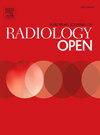High performance of low/ultralow-dose photon-counting CT for pulmonary metastasis in young musculoskeletal malignancy patients
IF 2.9
Q3 RADIOLOGY, NUCLEAR MEDICINE & MEDICAL IMAGING
引用次数: 0
Abstract
Purpose
To investigate the performance of chest photon-counting CT (PCCT) at low-dose (LD) and ultralow-dose (ULD) in young musculoskeletal malignancy patients with pulmonary metastasis and compare with prior standard-dose energy-integrating CT (EICT).
Materials and methods
From August to November 2023, this prospective study recruited consecutive participants with prior EICT images and grouped them into LD and ULD groups to receive PCCT examination. Two observers independently and blindly evaluated the image quality using a five-point Likert scale. Intraindividual differences between PCCT and EICT were compared using the Wilcoxon signed-rank test or paired samples t-test.
Results
The LD and ULD groups included 50 (19 [16; 21] years; 33 males) and 50 participants (19 [14; 21] years; 30 males), respectively. The interval between EICT and PCCT examinations was 116 (88.5; 194) days. Compared with EICT, PCCT obtained median effective dose reduction rates of 87.62 % (3.78 [3.15; 5.18] vs. 0.43 [0.39; 0.58] mSv; p < 0.001) and 92.58 % (3.92 [2.96; 4.95] vs. 0.27 [0.22; 0.34] mSv; p < 0.001) in the LD and ULD groups, respectively. For subjective assessments, PCCT has superior overall image quality (5 [5; 5] vs. 5 [4; 5]) and lung nodule visualization (5 [5; 5] vs. 5 [4; 5]) to EICT (all p-values <0.001).
Conclusion
PCCT provided higher image quality and lung nodule visualization with significant dose reduction compared to EICT in these young musculoskeletal malignancy patients.
低/超低剂量光子计数CT对年轻肌肉骨骼恶性肿瘤肺转移的高效诊断
目的探讨低剂量(LD)和超低剂量(ULD)胸部光子计数CT (PCCT)在年轻肌肉骨骼恶性肿瘤合并肺转移患者中的表现,并与既往标准剂量能量积分CT (EICT)进行比较。材料与方法本前瞻性研究于2023年8月至11月连续招募有EICT影像的受试者,将其分为LD组和ULD组接受PCCT检查。两名观察员独立和盲目评估图像质量使用五点李克特量表。PCCT和EICT的个体差异采用Wilcoxon符号秩检验或配对样本t检验进行比较。结果LD组50例(19[16;21]岁,男性33例),ULD组50例(19[14;21]岁,男性30例)。EICT与PCCT检查间隔116(88.5;194)天。与EICT相比,PCCT在LD组和ULD组的中位有效剂量减少率分别为87.62 %(3.78[3.15;5.18]比0.43 [0.39;0.58]mSv; p <; 0.001)和92.58 %(3.92[2.96;4.95]比0.27 [0.22;0.34]mSv; p <; 0.001)。在主观评价方面,PCCT具有优于EICT的整体图像质量(5 [5;5]vs. 5[4; 5])和肺结节显示(5 [5;5]vs. 5[4; 5])(所有p值<;0.001)。结论与EICT相比,pcct在年轻肌肉骨骼恶性肿瘤患者中具有更高的图像质量和更清晰的肺结节显示,且剂量明显降低。
本文章由计算机程序翻译,如有差异,请以英文原文为准。
求助全文
约1分钟内获得全文
求助全文
来源期刊

European Journal of Radiology Open
Medicine-Radiology, Nuclear Medicine and Imaging
CiteScore
4.10
自引率
5.00%
发文量
55
审稿时长
51 days
 求助内容:
求助内容: 应助结果提醒方式:
应助结果提醒方式:


